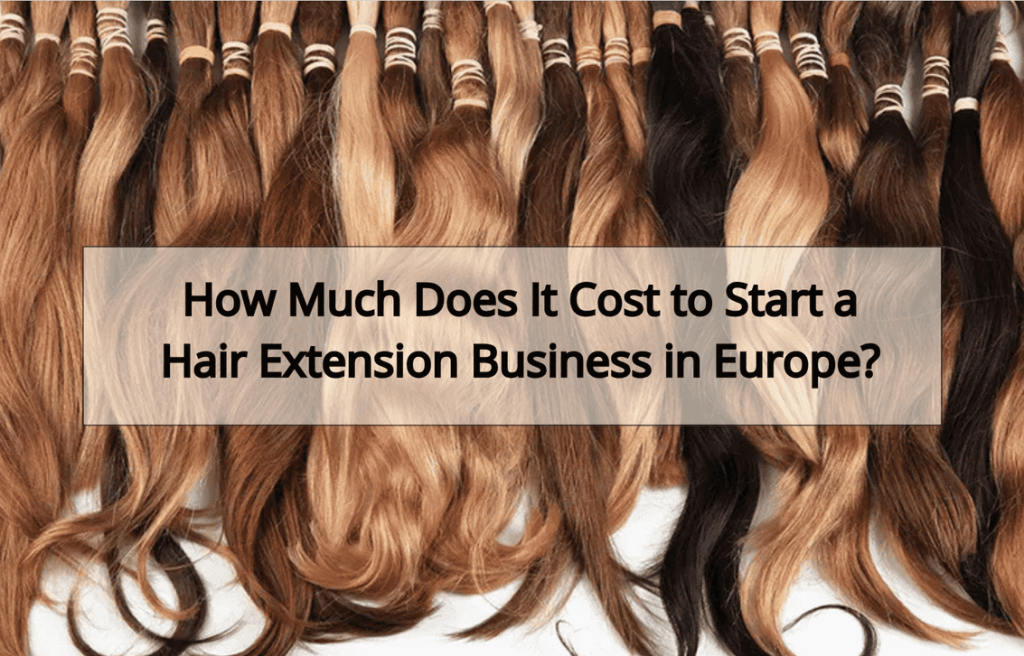Hair Business
How Much Does It Cost to Start a Hair Extension Business in Europe?
The hair extension industry in Europe is thriving, with increasing demand from both high-end salons and everyday consumers seeking volume, length, or style transformations. If you’re considering entering the market, one of the first questions is: How much does it cost to start a hair extension business in Europe? This article breaks down the startup investment, from minimum to full-scale salon models, to help you prepare for a successful launch in 2025.
I. Overview of the Hair Business Landscape in Europe
The European hair extension market is currently valued at over $1.2 billion USD, growing annually by 8–10% (source: Euromonitor 2024). Countries like Germany, France, and the UK lead in terms of demand, particularly for premium-quality hair such as virgin Vietnamese hair and ethically sourced Remy strands.
New entrepreneurs are entering the space through:
- Online stores with drop-shipping models
- Home-based studios
- Boutique salons offering professional installation services
The cost will largely depend on which model you choose and how fast you want to scale.
II. Main Cost Categories to Start a Hair Extension Business in Europe
Start a hair extension business involves more than just buying hair bundles. Whether you’re launching an online store, a home studio, or a full-service salon, here’s a breakdown of the essential cost categories you need to plan for:
1. Product Inventory (€2,000 – €10,000+)
This is the core of your business. You’ll need to purchase hair extensions in various types (clip-in, tape-in, keratin bond, wefts) and textures (bone straight, wavy, curly) to meet your target market’s preferences.
- Beginner stock: ~10–20 sets of hair bundles/extensions in the most popular colors and textures
- Pro tip: Start with Vietnamese virgin hair or Remy hair, known for durability and natural look
- Average cost per bundle: €30 – €80, depending on length, quality, and type
💡 If working with a Vietnamese supplier like N Hair Factory, you can negotiate low MOQ (minimum order quantity) to test the market.
2. Equipment & Tools (€500 – €3,000)
Even if you’re not installing extensions yourself, you’ll need professional tools if you offer services or create content.
-
Essential tools:
- Sectioning clips, tail combs, flat pliers (for tape-ins/micro rings)
- Hair tongs/irons, heat protectants
- Mannequin head for demo or training
-
For salons: Styling chairs, mirrors, washing basins, sterilization units
3. Business Registration & Legal Fees (€300 – €1,500)
Each EU country has its own regulations. You must register your business, apply for relevant permits, and possibly get liability insurance.
- Germany: Gewerbeanmeldung (~€50), plus possible VAT number
- France: Auto-entrepreneur registration is free but includes social charges
- UK: Registering as a sole trader is free, but you may want to incorporate for protection
Tip: Consider hiring a legal consultant for €500–€800 if you’re unsure about paperwork.
4. Branding & Packaging (€800 – €3,000)
Brand identity matters in the beauty industry. Customers want to buy from a trustworthy, professional-looking brand.
- Branding essentials: Logo design, brand color palette, fonts, slogan
- Packaging: Satin bags, branded boxes, care cards, thank-you notes
- Optional: Custom tags, QR code cards for reorders
A polished brand builds long-term loyalty and positions your products as premium.
5. Website & E-commerce Setup (€1,000 – €3,500)
An optimized website is essential, even if you’re selling through Instagram or marketplaces.
- Platform: Shopify, WooCommerce (for WordPress), Wix
- Initial setup: Homepage, product pages, FAQ, blog, contact form
- Professional design cost: €1,500–€2,500 if outsourced
- Essential SEO optimization: To rank in search engines and reach European buyers
Make sure your website supports multi-language and EU-compliant payment/shipping/tax settings.
6. Marketing & Advertising (€2,000 – €5,000 for first 6 months)
Even the best product won’t sell if nobody knows about it. Digital marketing is your most important growth tool.
- Paid ads: Google Ads, Meta Ads (Facebook + Instagram), TikTok Ads
- Organic growth: Instagram reels, TikTok tutorials, Pinterest pins
- Influencer collaborations: €100 – €1,000 per influencer
- Email marketing & automation tools: Mailchimp, Klaviyo, etc.
💡 Set aside at least 20–30% of your startup budget for marketing to drive initial traction.
7. Training / Certification (€500 – €2,000)
If you or your team will install hair extensions, formal training is crucial for both skills and credibility.
- Hair extension certification (tape-in, keratin, sew-in): €500 – €1,500
- Online courses or in-person academies available
- Some suppliers (like N Hair) offer free installation training for buyers
8. Salon Rental (if applicable) (€800 – €3,000/month)
For those starting a physical salon, rent will be your largest recurring cost.
- Urban areas: Higher cost, higher foot traffic
- Rural/suburban: Lower cost, but limited exposure
- Consider coworking salon spaces to reduce costs and risk
9. Miscellaneous Costs (€500+)
Unexpected expenses always come up. This can include:
- Tax/accounting services
- Additional licenses
- Sample giveaways for marketing
- Travel costs to meet suppliers or attend expos
| Category | Estimated Cost (EUR) |
|---|---|
| Product Inventory | €2,000 – €10,000 |
| Equipment & Tools | €500 – €3,000 |
| Business Registration & Legal | €300 – €1,500 |
| Branding & Packaging | €800 – €3,000 |
| Website & E-commerce setup | €1,000 – €3,500 |
| Marketing & Advertising | €2,000 – €5,000 (6 months) |
| Training / Certification | €500 – €2,000 |
| Rent (if salon-based) | €800 – €3,000/month |
| Miscellaneous | €500+ |
✅ Minimum investment for small-scale/home studio: €4,000 – €8,000
🏢 For a full-service salon: €15,000 – €40,000+
III. Cost Breakdown by Business Model
The cost of starting your hair extension business in Europe largely depends on the business model you choose. Below is a breakdown of the three most common models with realistic estimates to help you plan accordingly.
1. Home-Based Business / Online Store
Best for: Beginners, part-time entrepreneurs, those with a small initial budget
Startup cost estimate: €3,000 – €10,000
Key cost components:
- Initial inventory (test quantity): €2,000 – €4,000
- E-commerce website setup: €1,000 – €2,000
- Packaging and branding: €500 – €1,500
- Digital marketing: €1,000 – €2,000
- Legal/registration: €300 – €500
- Equipment/tools: €200 – €500
💡 Tip: This model works well if you build a strong presence on Instagram, TikTok, or Pinterest. Many EU buyers look for hair extensions via social platforms.
2. Mobile or Studio-Based Hair Extension Service
Best for: Freelancers, certified hair stylists, part-time salon operators
Startup cost estimate: €7,000 – €15,000
Key cost components:
- Product stock + tools: €3,000 – €5,000
- Mobile equipment (portable chair, trolley, lighting): €1,000 – €2,000
- Certification courses: €500 – €1,500
- Booking system or website: €800 – €1,500
- Marketing (Google Maps, local ads, IG reels): €1,000 – €3,000
- Insurance & registration: €300 – €1,000
💡 Tip: You can start from home and offer in-home services for clients, then gradually move into a studio space.
3. Full-Service Hair Salon or Boutique
Best for: Experienced stylists, investors, or those looking to build a premium brand
Startup cost estimate: €15,000 – €50,000+
Key cost components:
- Salon rent and renovation: €5,000 – €20,000
- Hair inventory (tape-in, clip-in, keratin, wigs): €5,000 – €10,000
- Equipment & furnishings: €5,000 – €15,000
- Branding & professional website: €2,000 – €4,000
- Marketing & influencer partnerships: €3,000 – €8,000
- Staff training or hiring: €1,000 – €5,000
- Utilities, insurance, licenses: €500 – €2,000
💡 Tip: Consider a hybrid model—offering walk-in services + selling retail products (clip-ins, care kits) to boost profits.
Summary Comparison Table
| Business Model | Estimated Startup Cost | Pros | Challenges |
|---|---|---|---|
| Online Only | €3,000 – €10,000 | Low cost, flexible, great for testing | Harder to build trust without physical presence |
| Mobile/Studio-Based | €7,000 – €15,000 | Personal client relationships, lower rent | Requires training, travel time, equipment setup |
| Full-Service Salon | €15,000 – €50,000+ | High profit potential, premium brand image | High upfront costs, more complex management |
IV. Tips to Optimize Your Budget When Start a Hair Extension Business
1. Start Small, Then Scale
Instead of investing in a wide range of textures and lengths upfront, begin with best-selling options—such as straight or body wave virgin hair in popular lengths (16″–22″).
💡 Focus on 2–3 hero products first, then expand based on customer feedback.
2. Order Sample Kits Before Buying in Bulk
Never buy inventory in bulk from new suppliers without testing the product.
Request sample bundles or small wholesale orders to verify quality, processing, and customer service.
🔍 N Hair Factory, for example, allows new EU businesses to order in small quantities for testing purposes.
3. Leverage Digital Tools Instead of High Rent
If you’re just starting out, skip expensive retail locations.
Invest in:
- A professional website (€1,000–€2,000)
- Booking apps like Fresha or Treatwell (often free)
- Free Google Business Profile for local SEO
📱 Social media + online booking > high-traffic retail store, especially in the early phase.
4. Use Freelancers for Branding & Marketing
You don’t need a full-time team to get started. Use platforms like Fiverr or Upwork to hire freelance designers, copywriters, and even social media managers—at a fraction of the cost.
🎨 You can get a brand kit (logo, colors, fonts) for under €200.
5. Choose Suppliers That Offer Customization & Support
Work with manufacturers who offer private labeling, branding support, and fast shipping to EU countries. This saves time and cost on printing, packaging, and logistics.
✨ N Hair Factory, for instance, offers free packaging design and international shipping options tailored for European salons.
6. Partner with Micro-Influencers (Not Celebrities)
Big influencers charge thousands. But local micro-influencers (1k–10k followers) often offer better engagement at lower cost.
📸 Offer them a free product or small payment in exchange for authentic reviews and before/after reels.
7. Invest in Hair Education Early
Instead of trial-and-error, take an online or in-person hair extension certification course.
This helps you avoid costly mistakes, build credibility, and price your services professionally.
💡 Many EU courses offer official accreditation from as low as €300.
8. Buy In Bundles & During Sales
Negotiate with suppliers for:
- Bundle discounts (e.g., 20 pieces of tape-ins = 10% off)
- Seasonal offers (e.g., Black Friday, Lunar New Year deals)
📦 Bulk purchasing + smart timing = lower cost per unit.
Final Tip: Track Everything
Use free or affordable tools like Google Sheets or Notion to track:
- Inventory costs
- Marketing spend
- Revenue per client
📊 Clear visibility into your cash flow is the foundation of smart growth.
Final Thoughts: Is It Worth to Start a Hair Extension Business?
Yes—if you plan wisely. Hair extension services in Europe are high-margin, with an average ROI within 6–12 months. By choosing the right suppliers, focusing on quality, and building a trusted brand, you can establish a strong and sustainable business.
If you’re still unsure where to begin, start small, test your market, and scale from there. Europe’s demand for professional hair services and premium hair extensions shows no signs of slowing down.





